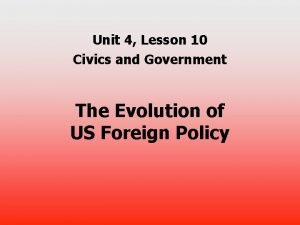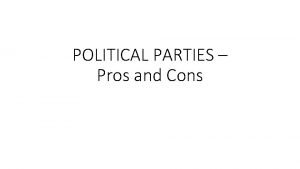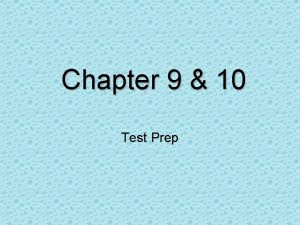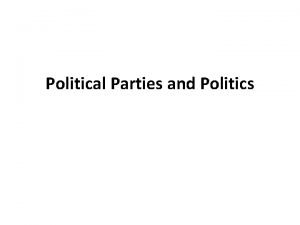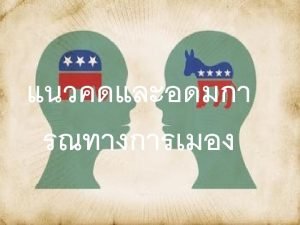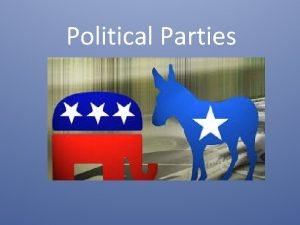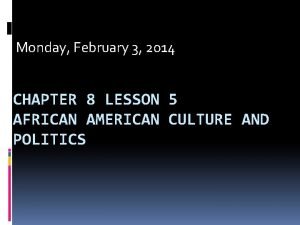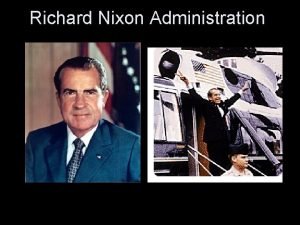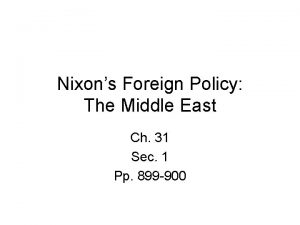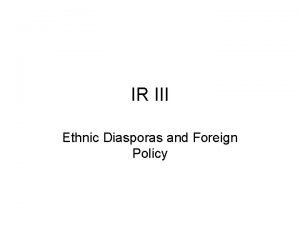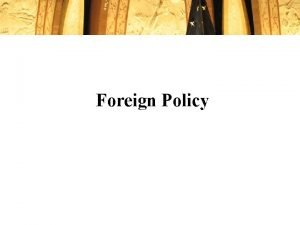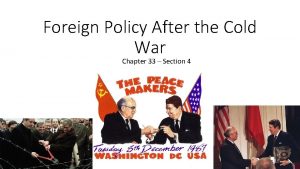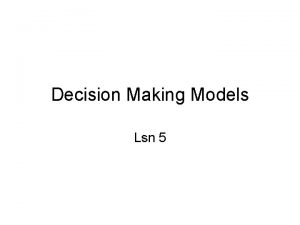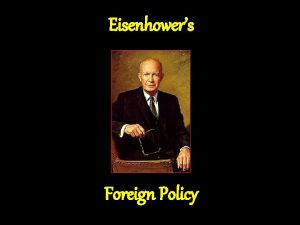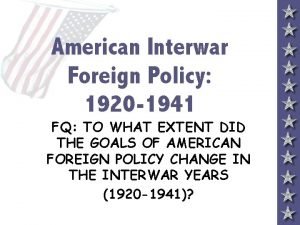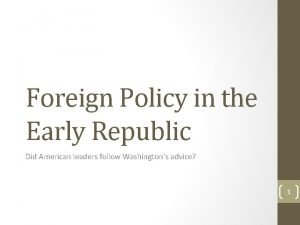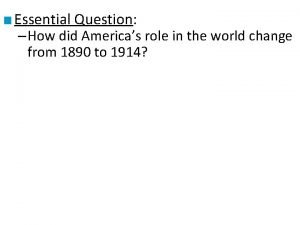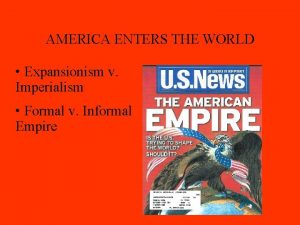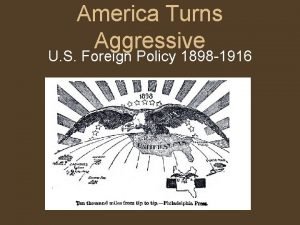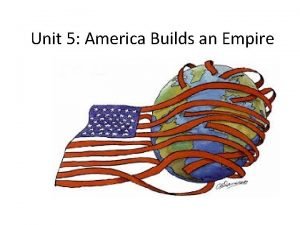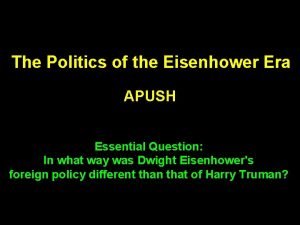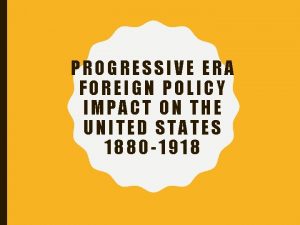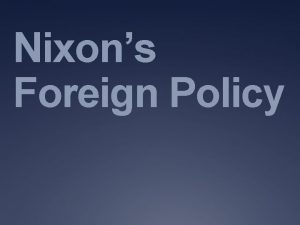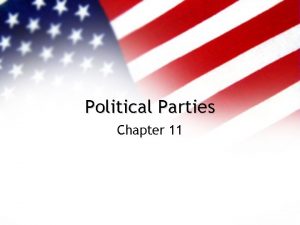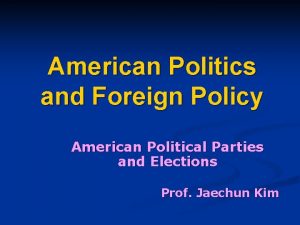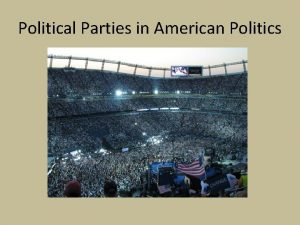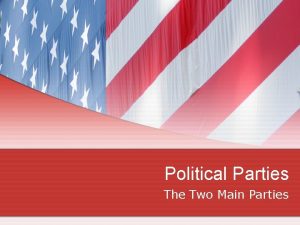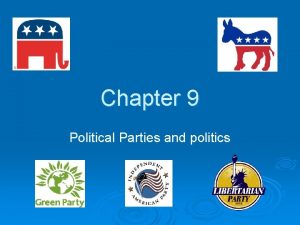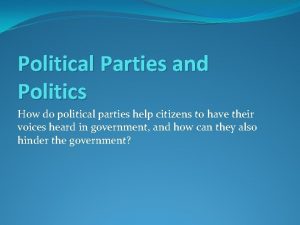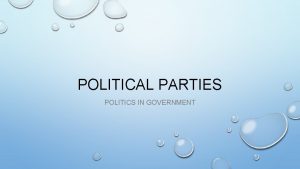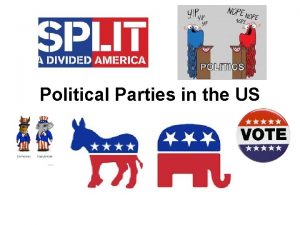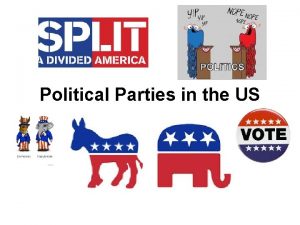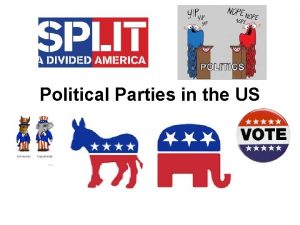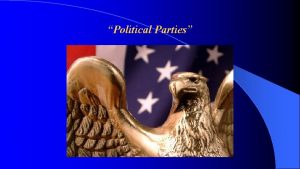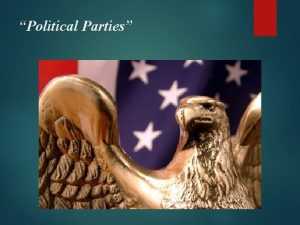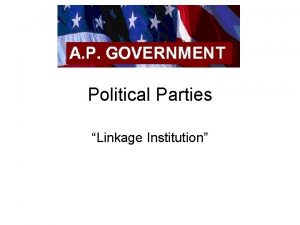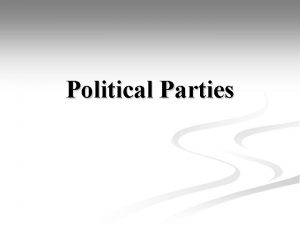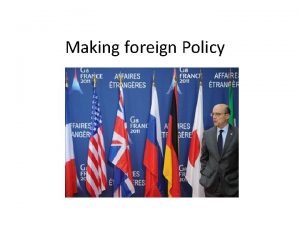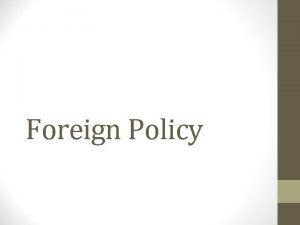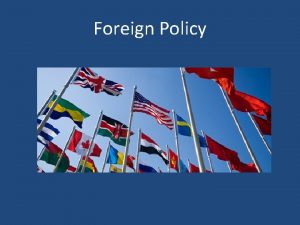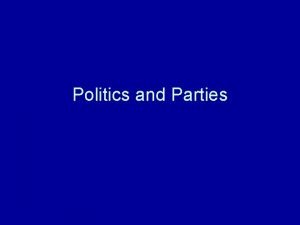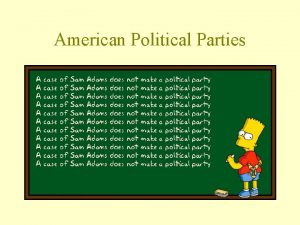American Politics and Foreign Policy American Political Parties

































- Slides: 33

American Politics and Foreign Policy American Political Parties and Elections Prof. Jaechun Kim

Elections * One of the distinct characteristics of the American national elections – candidates for most public offices are elected (mostly) by open primary elections. *What is open primary? How does this affect American politics? American presidential election n If you want to become presidents in the US, you have to win two election! n Primary Elections (to Determine Candidacy (or Nomination) n Both primaries and final elections take on the nature of “beauty contest” Sometimes personal characters matter more… (basically in every elections in the world…) n For their partys’ presidential candidates, people (usually) tend to support less ideological candidates… Why? n e. g. , The fate of Howard Dean in 2004 Democratic primary… but not anymore maybe…

n Caucus and Primaries Caucus - Voting is conducted at local party meetings and is done by raising hands or breaking up into groups n Primary - An election is held with secret ballot n n Types of Primaries Closed Primaries – open to party members n Open Primaries – basically open to anyone n n Up to the states!

Differences between Caucus and Primary Caucus Primary Voting is conducted at local party meetings and is done by raising hands or breaking up into groups. An election is held/ with secret ballot Who can vote Only members registered with the political party can participate (if closed system) Depends upon the state. Some states allow only registered party members to vote; some allow party registrations on the same day; some are completely open to all residents of the state. States that use the caucus system are Alaska, Colorado, Hawaii, Kansas, Maine, Minnesota, Nevada, North Dakota, Wyoming and Iowa All other states Voting method

n Importance of early primaries (New Hampshire Primary and Iowa Caucus) § Bandwagon Effect. . also Funding becomes easier. . e. g. , John Kerry in 2004… and Obama in 2008… § § Complaint - “Iowa (94% whites) and New Hampshire (96% whites) are about as ethnically diverse as a reunion of Mayflower descendants, ” nonetheless huge impact… § § Every state wants to hold primaries earlier! Why? ? n Super Tuesday – 9 southern states (Texas, Florida, Tennessee, Louisiana, Oklahoma, Mississippi, Kentucky, Alabama, and Georgia) hold primaries together. e. g. , 1992 Paul Tsongas vs. Bill Clinton n In 2008, California, NY, NJ, MA, Missouri, IL… 24 states participated in Super Tuesday!!!

v State Electoral Votes in 2000 The map of the United States shown here is distorted to show the relative weight of the states in terms of electoral votes in 2000. Considering that a candidate must win 270 electoral votes to be elected, presidential candidates plan their visits around the nation to maximize their exposure in the most important states. As vice president, Al Gore visited California numerous times in anticipation of the 2000 elections.

n Electoral College System n American presidential election – direct election or indirect election? n The total number of electors today is 538, equal to 100 senators, 435 members of the House, plus 3 electors for the District of Columbia (subsequent to the Twenty-third Amendment, ratified in 1961). Each state's number of electors equals that state's number of senators (two) plus its number of representatives in the House. n The electors are pledged to the candidates chosen. The Constitution does not, however, require the electors to cast their ballots for the candidates of their party. (Up to the states…) n The magic number is 270!!! According to the Constitution, if no candidate receives a majority of the electoral votes (e. g. , 269 – 269), the election of the president is decided in the House.

n n Origins of Electoral College System n The framers of the Constitution wished the choice to be made by a few supposedly dispassionate, reasonable men (but not women)… but not anymore! When was it changed? ? n To solidify legitimacy of the president? Majority president vs. plurality president… n Ensure representation of small states… ? ? Problems of Electoral College System n The possibility of a candidate's being elected when the opposing candidate receives a plurality of the popular vote.

ü ü ü 1824 John Quincy Adams v. Andrew Jackson 1876 Rutherford Hayes vs. Samuel Tilden. . House voted for Hayes (R) 1888 Benjamin Harrison vs. Grover Cleveland 2000 Al Gore vs. George W. Bush 540, 000 votes more… but 271 v 266… (red states being overrepresented…) 2016 Trump vs. Clinton; 62, 984, 825 vs. 65, 853, 516 but 306 vs. 232 n Since it is winter-takes-it all kind of system, the system works to the disadvantage of the third parties… 1992 Ross Perot – 19% of popular votes, but not a single electoral vote… n The current system of voting also means that presidential campaigning will be concentrated in those states that have the largest number of electoral votes (actually swing states…) All of the other states generally get second-class treatment during the presidential campaign.

n Voting in some states doesn’t mean anything! e. g. , Voters in Texas bother to go to ballot box? n Why not modifying it? Why not popular election? n n Constitutional amendment required… n The major parties are not in favor of eliminating the electoral college… fearing the emergence of third parties… Importance of swing states!! n Battleground states…

*2004 Presidential Election



n What about 2008, 2012 election? Who voted for who? n Which states voted for who? n n 2016 election analysis a little late during the presentation

Campaign Financing n Money is mother milk of politics! ü The Federal Elections Campaign Acts 1972, 1974 To reduce the influence of wealthy donors ü ü Buckley v. Valeo. The 1972 act had also limited the amount that each individual could spend on his or her own behalf. The Supreme Court declared the provision unconstitutional in 1976, in Buckley v. Valeo, stating that it was unconstitutional to restrict in any way the amount congressional candidates or their immediate families could spend on their own behalf: "The candidate, no less than any other person, has a First Amendment right to engage in the discussion of public issues and vigorously and tirelessly to advocate his own election. “ ü No spending limit!

n Direct contribution ü Individual – up to $1, 000 for each candidate per election ü PAC (Political Action Committee)s – corporations, labor unions, and special interest groups set up PACS. At least 50 volunteer donors. . At least 5 candidates in federal election. . entitled to one PAC. . n Indirect contribution “Soft money” for voter education and strengthening party orgs… no limits. . cf. The Bipartisan Campaign Reform Act of 2002 (BCRA) a. k. a. , the Mc. Cain-Feingold Bill – banning soft money

n Supreme Court rejects limits on corporate spending in electoral campaigns January 21, 2010; 1: 40 PM n A lobbyist can now tell any elected official: if you vote wrong, my company, labor union or interest group will spend unlimited sums explicitly advertising against your reelection. B. Obama

American Political Parties History v The United States has a two-party system, and that system has been around from about 1800 to the present. v We can divide the evolution of the US political parties into six periods: 1. 2. 3. 4. 5. 6. The creation of parties, from 1789 to 1812. The era of one-party rule, or personal politics, from 1816 to 1828. The period from Andrew Jackson's presidency to just prior to the Civil War, from 1828 to 1860. The post-Civil War period, from 1864 to 1892. The progressive period, from 1896 to 1928. The modern period, from 1932 to the present.


n The Formative Years: Federalists and Anti-Federalists (1789 -1812) ü The Federalists represented those with commercial interests, including merchants, ship-owners, and manufacturers. The Federalists supported the principle of a strong (federal) national government. ü The Anti-Federalists (the Democratic Republicans) represented artisans and farmers. They strongly supported states’ rights vis-à-vis the central government’s. . . ü The Federalists dominant in the North and the Democratic Republicans dominant in the South.

n The Era of Personal Politics (1816 -1828) ü ü n Dominance of the Democratic Republicans… Voters’ attention was centered on the characters of individual candidates rather than on party identification. National Two-party Rule: Democrats and Whigs (1828 to 1860) ü Intraparty rivalry within the Democratic Republicans Split factions of Henry Clay and John Quincy Adams vs. Andrew Jackson The Democratic Party (Andrew Jackson) and the Whig Party (Clay-Adams bloc); the world’s oldest democratic political party… ü The Whigs became increasingly divided over the issue of slavery in the late 1840 s. During the 1850 s, the Whigs fell apart as a national party.

n The Post-Civil War Period (1864 to 1892) ü The new Republican Party was created in the mid-1850 s from the various groups that sought to fill the vacuum left by the disintegration of the Whigs. = Grand Old Party (GOP) ü After the end of the Civil War, the South became heavily Democratic (the Solid South), and the North became heavily Republican! (However this changes!!!) u Dominance of the GOP - From the election of Abraham Lincoln until the election of Franklin D. Roosevelt in 1932, the Republicans won all but four presidential elections.

v The Progressive Movement ü In 1912, the former Republican president Theodore Roosevelt campaigned for the presidency as a Progressive. ü Consequently, there were three significant contenders in that presidential contest. Woodrow Wilson was the Democratic candidate, William Howard Taft was the regular Republican candidate, and Roosevelt was the Progressive candidate. ü Republican Warren Harding's victory in 1920 reasserted Republican domination of national politics until the Republicans' defeat by Franklin D. Roosevelt in 1932, in the depths of the Great Depression.

n The Modern Era: From the New Deal to the Present (1932 to the present) ü Franklin D. Roosevelt was elected in 1932 and reelected in 1936, 1940, and 1944. The impact of his successive Democratic administrations and the New Deal that he crafted is still there in the US today!!!!! ü § 1932 to 1968 (Dominance of the Democratic Party) In April 1945, Roosevelt died; Vice President Harry Truman became president through succession and, in 1948, through election. The New Deal coalition, under Truman's revised theme of the Fair Deal, continued. Although Republican Dwight Eisenhower won the presidency in 1952 and was reelected in 1956, the Democrats regained control in 1960. Led first by John F. Kennedy and then by Lyndon B. Johnson, the Democrats held national power from 1960 through 1968.

§ 1968 to 1992 (Resurgence of the Republican Party) Republicans agained control of the presidency with Richard Nixon's victory in 1968 and retained it in 1972, but they lost prestige and public support after the Watergate scandal forced Nixon's resignation on August 8, 1974. For this and other reasons, the Democrats were back in power after the presidential elections in 1976. But Democratic president Jimmy Carter was unable to win reelection against Ronald Reagan in 1980. The Republicans also gained control of the Senate in 1980 and retained it in the elections of 1982 and 1984. The 1984 reelection of Ronald Reagan appeared to some pollsters to signal the resurgence of the Republican Party as a competitive force in American politics as more people declared themselves to be Republicans than had done so in the previous several decades. The election of George H. W. Bush in 1988 may have signaled the beginning of a true era of divided government. Republican Bush won the presidency, but his Republican Party lost seats in the House and Senate to Democrats.

§ 1992 to the 2000 (Bill Clinton’s presidency; Republican dominance in the Congress) In 1992, Democrat Bill Clinton won the presidency, with Democratic control of the House and Senate, but his party actually lost congressional seats, presaging the Democrats' debacle in 1994 when the Republicans took control of both the House and the Senate. In 1996, Bill Clinton was reelected, but the voters returned Republicans to control in Congress. Republicans also controlled most of the governorships in the states. After the 2000 elections, divided government took on a new meaning. n 2000 to 2008 (GWB, Republican dominance in Congress, and then Democrats’ resurgence in 2006) Although Republican George W. Bush won the presidency, Congress became almost evenly divided, with the Republicans holding a slim majority in the House and the Democrats holding an even narrower majority in the Senate. The Republicans succeeded in 2002 in holding on to the House and in regaining control of the Senate. In 2004, the Republican dominance continued. But because of the fiasco in Iraq, Republicans lost both chambers to the Democrats in November 2006 election (once again, divided government!).

n 2008 - Surge of Democrats!? 2010 midterm election results favored the Republicans… n After 2012 election, House is still controlled by the Republican party n n 2016 – Republicans control the presidency and both houses of the Congress! n 2018. 11 midterm election? – House controlled by the Dems.

Two major parties in the US – Democratic vs. Republican Party v Tweedledee and Tweedledum, the twins in Lewis Carroll's Through the Looking Glass Umbrella Party; Catch-all party , but not anymore? n The Parties' Core Constituents ü The Democratic Party has appealed to the more disadvantaged groups in the US… v § Racial minorities (African Americans; Latinos; Asian Americans; Jewish votes…); women rather than men; the working class (union members) – is it still true, though? ? ; Individuals who have less than a high school education; college graduates with a postgraduate education; homosexuals

§ The legacy of Roosevelt's New Deal - In general, Democratic identifiers are more likely to approve of social-welfare spending, to support government regulation of business, to approve of measures to improve the situation of minorities, and to support assistance to the elderly with their medical expenses. In sum, greater role of the (central) government! – contemporary liberal cf. classical liberalism… § Advocating rights of LGBT.

ü Republicans draw more of their support from college graduates with no postgraduate education, upper-income families, and professionals or businesspersons. (now also from the working class people? – Trump phenomenon…) § Republicans are more supportive of the private marketplace, and many Republicans feel that the federal government should be involved in fewer social programs. – classical liberalism… § Traditional values (family values; church); opposition to gay marriage and gays serving in the military


n Other Party Differences Which Party is Better?

n Republicans Moral (social) conservatives n Fiscal (economic) conservatives n National security conservatives n n Resurgence of Ideological Party Politics in Recent Years… polarized partisan politics!! n How can we explain this? ? - I am curious…
 Unit 4 lesson 10 american foreign policy
Unit 4 lesson 10 american foreign policy Lesson 5: american foreign policy
Lesson 5: american foreign policy Political parties pros and cons
Political parties pros and cons Brainpop political parties
Brainpop political parties What was one way progressives differed from populists
What was one way progressives differed from populists Political parties
Political parties Political parties
Political parties A political party is an association of
A political party is an association of Soup and ideology
Soup and ideology Political parties
Political parties Here you are too foreign for home
Here you are too foreign for home Chapter 8 lesson 5 african american culture and politics
Chapter 8 lesson 5 african american culture and politics 1790 foreign policy
1790 foreign policy Foreign policy of louis philippe
Foreign policy of louis philippe What was thomas jefferson foreign policy
What was thomas jefferson foreign policy Nixons foreign policy
Nixons foreign policy Nixons foreign policy
Nixons foreign policy Actors in foreign policy
Actors in foreign policy Definition of foreign policy by scholars
Definition of foreign policy by scholars Chapter 33 section 4 foreign policy after the cold war
Chapter 33 section 4 foreign policy after the cold war Actors in foreign policy
Actors in foreign policy Truman foreign policy vs eisenhower
Truman foreign policy vs eisenhower Interwar america
Interwar america Hitler's foreign policy timeline
Hitler's foreign policy timeline Foreign policy in the early republic
Foreign policy in the early republic Foreign policy imperialism
Foreign policy imperialism Foreign policy imperialism
Foreign policy imperialism Andrew johnson foreign policy
Andrew johnson foreign policy President taft’s foreign policy emphasized
President taft’s foreign policy emphasized Foreign policy
Foreign policy Iranian coup apush
Iranian coup apush Dollar diplomacy pros and cons
Dollar diplomacy pros and cons Foreign policy shift
Foreign policy shift Nixons vietnamization policy
Nixons vietnamization policy
